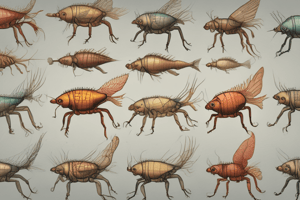Podcast
Questions and Answers
Describe the diversity of the phylum Arthropoda.
Describe the diversity of the phylum Arthropoda.
Phylum Arthropoda are the most diverse out of all the animal phylums with close to a million species described. A good 80% of all animal species belong to this group, with insects being the largest majority.
What do these animals all have in common (what are their shared characteristics)?
What do these animals all have in common (what are their shared characteristics)?
All arthropods share characteristics such as jointed limbs and appendages, a chitinous exoskeleton, good senses, and bilateral body symmetry.
How many arthropods have been described at the current time? How many are thought to exist on our planet?
How many arthropods have been described at the current time? How many are thought to exist on our planet?
There are about 1 million Arthropoda described, with an estimated number of 1.8 million, plus or minus 1.3 million.
What is metamerism? How has the process of tagmosis and metamerism favored the success of the phylum Arthropoda?
What is metamerism? How has the process of tagmosis and metamerism favored the success of the phylum Arthropoda?
Describe the specific structure of the exoskeleton. Name the different layers of the insect integument.
Describe the specific structure of the exoskeleton. Name the different layers of the insect integument.
How is the exoskeleton produced? What is it made of?
How is the exoskeleton produced? What is it made of?
What is the function of the exoskeleton? Give four examples.
What is the function of the exoskeleton? Give four examples.
Discuss the disadvantages with an exoskeleton.
Discuss the disadvantages with an exoskeleton.
Describe the process of ecdysis in an arthropod. How does a newly molted arthropod differ from one that molted a couple of weeks earlier?
Describe the process of ecdysis in an arthropod. How does a newly molted arthropod differ from one that molted a couple of weeks earlier?
What is metamorphosis? Briefly describe the process and give examples of arthropods in which the process is found.
What is metamorphosis? Briefly describe the process and give examples of arthropods in which the process is found.
Flashcards are hidden until you start studying
Study Notes
Diversity of Arthropoda
- Phylum Arthropoda is the most diverse animal phylum with nearly 1 million described species.
- Approximately 80% of all animal species belong to this phylum.
- Insects represent the largest majority, with beetles having the highest number of species.
- Their versatility allows them to occupy various ecological niches, including airborne environments.
Shared Characteristics of Arthropods
- Arthropods possess jointed limbs and appendages, a chitinous exoskeleton, acute sensory systems, and bilateral symmetry.
- They are segmented invertebrates, typically with a body organized into a head, thorax, and abdomen.
Estimated Number of Arthropods
- Around 1 million species of arthropods have been described with an estimated total between 1.8 million and 3.1 million existing on Earth.
Metamerism and Tagmosis
- Metamerism refers to having a series of body segments fundamentally similar in structure, allowing for specialization of body organs.
- Tagmosis, the specialization of body segments, has contributed to the rapid evolution and diversification of arthropods, making them the most abundant animal group.
Structure of the Exoskeleton
- The exoskeleton consists of chitin and varies in hardness across body regions.
- It has several layers:
- Epicuticle (outermost layer, protects against moisture loss)
- Exocuticle (provides strength, secreted by the epidermis)
- Endocuticle (more flexible, resists stress)
- Epithelium (directly under the cuticle layers).
Production and Composition of Exoskeleton
- The exoskeleton is primarily composed of chitin, reinforced by minerals and proteins in certain areas to enhance hardness.
Functions of the Exoskeleton
- Offers protection against predators and desiccation.
- Provides structural support and muscle attachment for movement.
- Allows for evolutionary adaptations in body shapes, such as modifications to mouthparts.
Disadvantages of the Exoskeleton
- Movement may be hindered due to the hard, chitinous nature.
- Gas exchange becomes more complex compared to organisms with softer bodies.
- Molting (ecdysis) poses challenges; organisms become vulnerable post-molt.
Ecdysis Process
- Ecdysis is initiated when the organism releases fluids to weaken the old exoskeleton, causing it to rupture as a new exoskeleton forms.
- Newly molted arthropods have soft exoskeletons, making them susceptible to predation and highly sensitive due to increased sensory reception.
Metamorphosis in Arthropods
- Metamorphosis is a process of significant physical change in an organism after birth or hatching, involving various stages of development.
- Complete metamorphosis includes four stages: egg, larva, pupa, and adult.
- After egg hatching, a larva develops and later transitions through a pupal stage, often forming a protective structure like a cocoon.
Studying That Suits You
Use AI to generate personalized quizzes and flashcards to suit your learning preferences.




